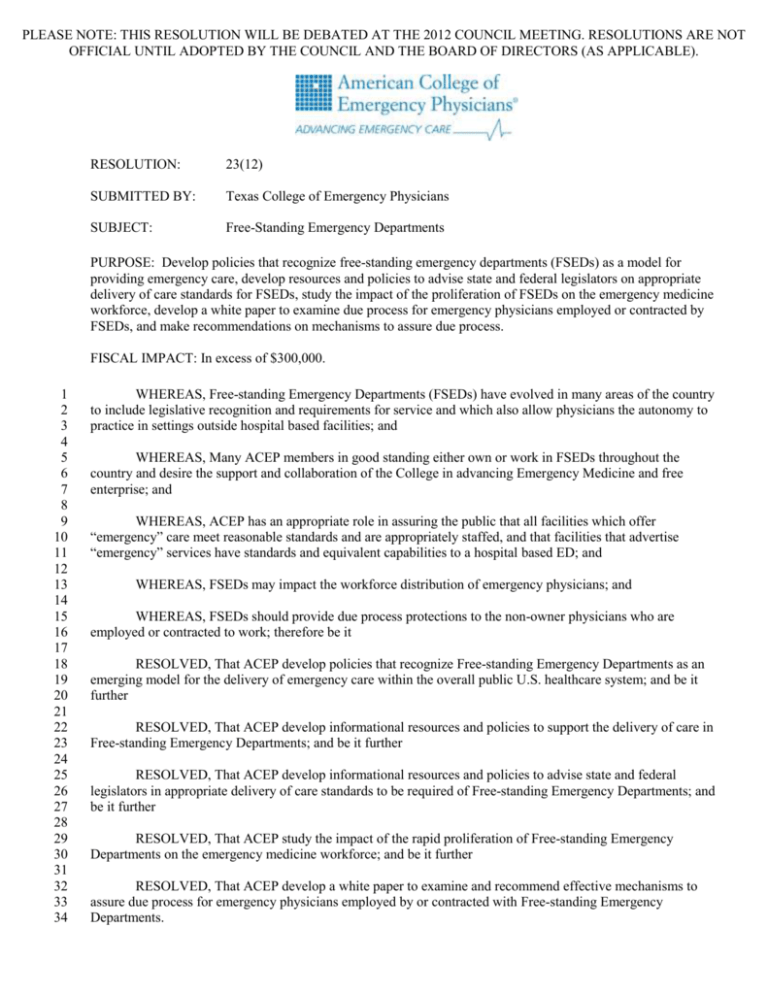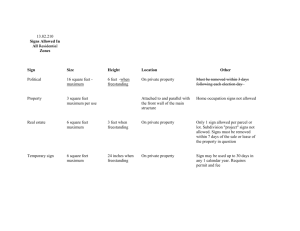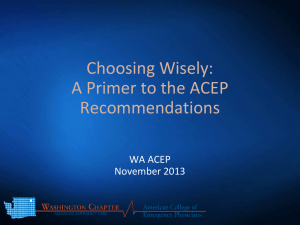AMERICAN COLLEGE OF EMERGENCY PHYSICIANS
advertisement

PLEASE NOTE: THIS RESOLUTION WILL BE DEBATED AT THE 2012 COUNCIL MEETING. RESOLUTIONS ARE NOT OFFICIAL UNTIL ADOPTED BY THE COUNCIL AND THE BOARD OF DIRECTORS (AS APPLICABLE). RESOLUTION: 23(12) SUBMITTED BY: Texas College of Emergency Physicians SUBJECT: Free-Standing Emergency Departments PURPOSE: Develop policies that recognize free-standing emergency departments (FSEDs) as a model for providing emergency care, develop resources and policies to advise state and federal legislators on appropriate delivery of care standards for FSEDs, study the impact of the proliferation of FSEDs on the emergency medicine workforce, develop a white paper to examine due process for emergency physicians employed or contracted by FSEDs, and make recommendations on mechanisms to assure due process. FISCAL IMPACT: In excess of $300,000. 1 2 3 4 5 6 7 8 9 10 11 12 13 14 15 16 17 18 19 20 21 22 23 24 25 26 27 28 29 30 31 32 33 34 WHEREAS, Free-standing Emergency Departments (FSEDs) have evolved in many areas of the country to include legislative recognition and requirements for service and which also allow physicians the autonomy to practice in settings outside hospital based facilities; and WHEREAS, Many ACEP members in good standing either own or work in FSEDs throughout the country and desire the support and collaboration of the College in advancing Emergency Medicine and free enterprise; and WHEREAS, ACEP has an appropriate role in assuring the public that all facilities which offer “emergency” care meet reasonable standards and are appropriately staffed, and that facilities that advertise “emergency” services have standards and equivalent capabilities to a hospital based ED; and WHEREAS, FSEDs may impact the workforce distribution of emergency physicians; and WHEREAS, FSEDs should provide due process protections to the non-owner physicians who are employed or contracted to work; therefore be it RESOLVED, That ACEP develop policies that recognize Free-standing Emergency Departments as an emerging model for the delivery of emergency care within the overall public U.S. healthcare system; and be it further RESOLVED, That ACEP develop informational resources and policies to support the delivery of care in Free-standing Emergency Departments; and be it further RESOLVED, That ACEP develop informational resources and policies to advise state and federal legislators in appropriate delivery of care standards to be required of Free-standing Emergency Departments; and be it further RESOLVED, That ACEP study the impact of the rapid proliferation of Free-standing Emergency Departments on the emergency medicine workforce; and be it further RESOLVED, That ACEP develop a white paper to examine and recommend effective mechanisms to assure due process for emergency physicians employed by or contracted with Free-standing Emergency Departments. Resolution 23 (12) Free-Standing Emergency Departments Page 2 Background This resolution calls for ACEP to develop policies that recognize freestanding emergency departments (FSEDs) as a model for providing emergency care and to develop resources and policies to advise state and federal legislators on appropriate delivery of care standards for FSEDs. The resolution also calls for the College to study the impact of the proliferation of FSEDs on the emergency medicine workforce and develop a white paper to examine due process for emergency physicians employed or contracted by FSEDs and make recommendations on mechanisms to assure due process. The ACEP policy statement “Definition of Emergency Medicine” http://www.acep.org/Content.aspx?id=29164 states “Emergency medicine may be practiced in a hospital-based or freestanding emergency department, in an urgent care clinic, in an emergency medical response vehicle or at a disaster site.” The American Hospital Association defines a freestanding emergency department as a facility that provides unscheduled outpatient services to patients whose conditions require immediate care in a setting that is geographically removed from a hospital. FSEDs are generally hospital or physician-owned, may operate 24 hours per day or on a more limited schedule and may or may not receive patients by ambulance. According to the American Hospital Association Hospital Statistics,1 in 2010 there were 200 freestanding/satellite emergency departments (EDs) in the US. This number increased in 2011 to 256 and to 284 in 2012. AHA defines satellite EDs as facilities owned and operated by a hospital but physically separate from the hospital for the provision of unscheduled outpatient care. In 2009, an Issue Brief titled “Freestanding Emergency Departments”1 stated that 91% of the FSEDs operate 24 hours a day and 86% are hospital affiliated. Federal regulations permit FSEDs to operate. State regulation and licensing varies. Some states require FSEDs to meet the same requirements as hospital EDs and operate under the license of a hospital. Some states require licensing as a FSED and must comply with those state regulations. The College has communicated with CMS about FSEDs to address federal regulatory issues and has provided input when requested. The Emergency Medicine Practice Committee developed an information paper “Freestanding Emergency Care Centers” in August 2009 that defines freestanding emergency care facilities, addresses ownership concerns and identifies market forces that facilitate their development. This paper was distributed to ACEPs chapters. In 2008, ACEP conducted an emergency medicine workforce study. Freestanding EDs were not included in this survey. The cost to conduct the last workforce study was more than $300,000. While not specifically referencing FSEDs, several ACEP policy statements support due process for emergency physicians. The policy statement “Definition of Democracy in Emergency Medicine Practice” http://www.acep.org/Content.aspx?id=43014 approved in June 2008 states: “All members/owners of the group should have:…access to a fair due-process procedure…” The April 2008 policy statement “Emergency Physician Rights and Responsibilities” http://www.acep.org/Content.aspx?id=29418 states “Emergency physicians shall be accorded due process before any adverse final action with respect to employment or contract status, the effect of which would be the loss or limitation of medical staff privileges. Emergency physicians’ medical and /or clinical staff privileges shall not be reduced, terminated, or otherwise restricted except for grounds related to their competency or professional conduct.” Further the policy states “Emergency physicians who practice pursuant to an exclusive contract arrangement shall not be required to waive their individual medical staff due process rights as a condition of practice opportunity or privileges.” The policy statement “Emergency Physician Contractual Relationships” http://www.acep.org/Content.aspx?id=29222, approved in 2006 states: “Emergency physicians under contract to a hospital or other health care facility should have the right to qualify for and maintain medical staff membership and privileges as any other member of the medical staff. This right includes privileges to vote, serve on Resolution 23 (12) Free-Standing Emergency Departments Page 3 committees, hold office and the right to due process in the same general manner prescribed in the medical staff bylaws for other members of the medical staff.” The Emergency Medicine Practice Committee was assigned an objective for the 2012-2013 committee year to develop a PREP for the “Emergency Physicians Contractual Relationships” policy statement. Due process is a topic to be addressed in the PREP. 1. California Health Care Foundation. Issue Brief: Freestanding Emergency Departments: Do They Have a Role in California? July 2009. ACEP Strategic Plan Reference Improve quality, patient safety, and efficiency. Fiscal Impact Costs for a workforce study and developing and disseminating materials for state and federal legislation could exceed $300,000. Prior Council Action Substitute Resolution 30(84) Acute Ambulatory Care Facility as Generic Term adopted. Called for ACEP to reaffirm the Emergency Care Guidelines and develop definitions of various forms of ambulatory care facilities and emergency care facilities to be included in future Emergency Care Guidelines. Substitute Resolution 51(84) Advertising and Public Education of Free-standing Facilities adopted. Called for ACEP to encourage physicians and health care providers and health care facilities to emphasize in advertising their own positive attributes rather than to denigrate the capabilities of other providers or facilities. Amended Substitute Resolution 18(83) Board Eligibility adopted. Called for ACEP to support the ABEM stance to consider for eligibility, after individual review, any clinical practice hours performed in non-hospital based facilities. Substitute Resolution 40(79) Hospital and Freestanding Emergency Care Facilities adopted. Called for ACEP to set standards of care for facilities that present themselves to be sources of emergency care. Prior Board Action August 2009, reviewed the information paper “Freestanding Emergency Care Centers.” June 2008, approved “Definition of Democracy in Emergency Medicine Practice” April 2008, approved revised “Emergency Physician Rights and Responsibilities.” Revised and approved July 2001. Originally approved September 2000. April 2008, approved revised “Definition of Emergency Medicine.” Revised and approved April 2001. Reaffirmed October 1998. Revised and approved April 1994. Originally approved March 1986. January 2006, approved revised “Emergency Physician Contractual Relationships.” Revised and approved March 1999. Revised and approved August 1993. Originally approved October 1984. Substitute Resolution 30(84) Acute Ambulatory Care Facility as Generic Term adopted. Substitute Resolution 51(84) Advertising and Public Education of Free-standing Facilities adopted. Resolution 23 (12) Free-Standing Emergency Departments Page 4 Amended Substitute Resolution 18(83) Board Eligibility adopted. Substitute Resolution 40(79) Hospital and Freestanding Emergency Care Facilities adopted. Background Information Prepared By: Margaret Montgomery, RN, MSN Emergency Medicine Practice Manager Reviewed by: Marco Coppola, DO, FACEP, Speaker Kevin Klauer, DO, EJD, FACEP, Vice Speaker Dean Wilkerson, JD, MBA, CAE, Council Secretary and Executive Director




